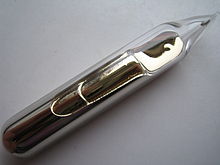| Revision as of 14:10, 18 September 2013 view sourceDouble sharp (talk | contribs)Autopatrolled, Extended confirmed users, Page movers, File movers, Pending changes reviewers102,107 edits And the dying star watched as it collapsed into a black hole, seeing the nuclei of heavy elements rushing out into deep space. It knew they would decay. Nevertheless it took delight in that moment, as much as it could, before collapsing into oblivion.← Previous edit | Revision as of 14:12, 18 September 2013 view source Double sharp (talk | contribs)Autopatrolled, Extended confirmed users, Page movers, File movers, Pending changes reviewers102,107 edits and naturally, I waste enough time writing weird stuff in the edit summary that I forgot to do thisNext edit → | ||
| Line 101: | Line 101: | ||
| |Brinell hardness=0.14 | |Brinell hardness=0.14 | ||
| |CAS number=7440-46-2 | |CAS number=7440-46-2 | ||
| |isotopes={{ |
|isotopes={{Elementbox_isotopes_decay | mn=133 | sym=Cs | na=100% | hl=- | dm=(]) | de=<34.753 | pn= | ps= }} | ||
| {{Elementbox_isotopes_decay2 | mn=134 | sym=Cs | {{Elementbox_isotopes_decay2 | mn=134 | sym=Cs | ||
| | na=] | hl=2.0648 ] | | na=] | hl=2.0648 ] | ||
Revision as of 14:12, 18 September 2013
Chemical element with atomic number (Cs)References
These references will appear in the article, but this list appears only on this page.- "Standard Atomic Weights: Caesium". CIAAW. 2013.
- Prohaska, Thomas; Irrgeher, Johanna; Benefield, Jacqueline; Böhlke, John K.; Chesson, Lesley A.; Coplen, Tyler B.; Ding, Tiping; Dunn, Philip J. H.; Gröning, Manfred; Holden, Norman E.; Meijer, Harro A. J. (2022-05-04). "Standard atomic weights of the elements 2021 (IUPAC Technical Report)". Pure and Applied Chemistry. doi:10.1515/pac-2019-0603. ISSN 1365-3075.
- Haynes, William M., ed. (2011). CRC Handbook of Chemistry and Physics (92nd ed.). Boca Raton, Florida: CRC Press. p. 4.121. ISBN 1-4398-5511-0.
- Dye, J. L. (1979). "Compounds of Alkali Metal Anions". Angewandte Chemie International Edition. 18 (8): 587–598. doi:10.1002/anie.197905871.
- "Magnetic susceptibility of the elements and inorganic compounds". Handbook of Chemistry and Physics (PDF) (87th ed.). CRC press. ISBN 0-8493-0487-3. Retrieved 2010-09-26.
- Kondev, F. G.; Wang, M.; Huang, W. J.; Naimi, S.; Audi, G. (2021). "The NUBASE2020 evaluation of nuclear properties" (PDF). Chinese Physics C. 45 (3): 030001. doi:10.1088/1674-1137/abddae.
- ^ "NIST Radionuclide Half-Life Measurements". NIST. Retrieved 2011-03-13. Cite error: The named reference "isotope" was defined multiple times with different content (see the help page).


